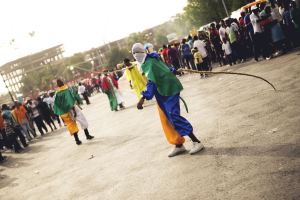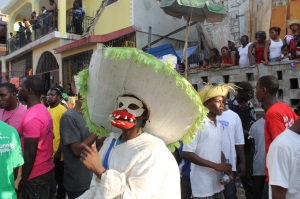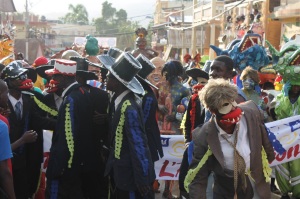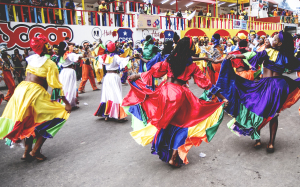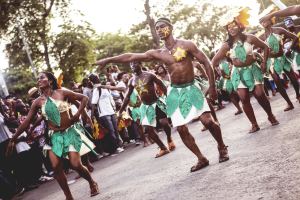This post is also available in: Kreyol
This post was originally written in: Kreyòl
Carnival in Haiti is a major cultural event celebrated through a combination of music and dance. One of the essential parts of the celebration is the many costumes and colors represented in the parades. This tradition officially began in the year 1927 where people would gather to watch small traveling bands or rara, and the groups of people in bright colorful costumes. Among the many costumes found were the: endyen, endou arab, janb debwa, Madan Deboure, Bèf, Chaloska etc. At the time, these carnival events would be over by sundown.
via Christian Nerette fotokanaval.com
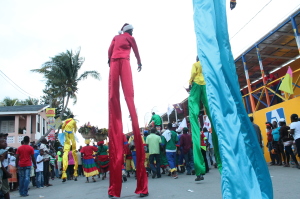 via Gio Jules giojules.com
via Gio Jules giojules.com
Among the various groups present in early Carnival celebrations, Chaloska was the most popular because this costume scared all children and even some adults. As soon as Chaloska showed up, people would run away. These men usually dressed in black, with lips painted brightly red first appeared in Jacmel’s Carnival. This costume represents General Charles Oscar Etienne, a military general under President Vilbrun Guillaume Sam who assassinated more than 100 political prisoners in the early 1900s.
Choukoun is a carnival costume of a Kreyòl woman. Women dawn their most beautiful make up, large earrings, and wrap their head in brightly colored cloths. Sometimes, these women stuff fabric under their garments to make them appear to have exaggeratedly large breasts and hind parts. This has become a regularly used insult, if someone is wearing clothing that is too big for them, people jokingly call them “Madan Deboure”.
 via Christian Nerette fotokanaval.com
via Christian Nerette fotokanaval.com
Another much loved carnival costume is the Endyen or Indian. These costumes allude to the period on the island before colonizers took over. These people dress themselves in skirts made of colorful straw. This is the inspiration many parents use when dressing their children up for Carnival themed events for students.
via Christian Nerette fotokanaval.comCarnival events began lasting through night time in 1948. A few years later, floats, or cha in Creole, carrying kings and queens of the Carnival parade and popular music groups were put into use.
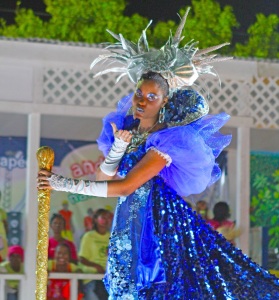
Today, Carnival in Haiti has 3 parts: the parade of costumes in the afternoon, traveling rara bringing local flavor and at night, and the procession of huge floats carrying the popular music groups playing their Carnival themed songs for the year until sunrise.
via Christian Nerette fotokanaval.com
Feuds between the popular Haitian bands have become a new Carnival tradition. The past few generations have had their share of famous band rivalries: Nemours vs. Sicot; Dipi vs. Scorpio; Sweet Micky vs. Mizik Mizik, and today T-Vice vs. Djakout (along with many others.) These days, the feuds between the bands dominate Carnival even more than the traditional costumes that represented it before. Today, each band strives to have the best sound, the best song worth dancing to, and the most fans.
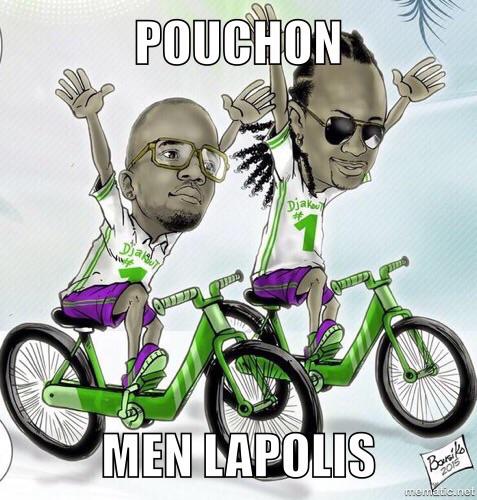
Despite all the changes each generation has brought to Carnival over the past 87 years, Carnival remains an event that gathers all Haitians and makes them proud of their culture. It is one big party that transcends all social barriers; bringing rich, poor, dark skinned, and light skinned people to one place. It is a manifestation of culture that brings the children of this land that are dispersed around the world back to their roots; permitting all Haitians to dance with all their souls to the same sound and expend the positive energy that this therapeutic celebration awakens in them.

